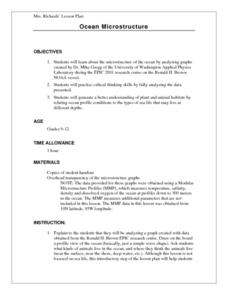Curated OER
Cold Fronts
Students determine its' direction of movement, and list at least five weather conditions associated with the specific front, given animations of several atmospheric variables during a cold front passage. They list at least three weather...
Curated OER
How much Carbon Dioxide is in My Seltzer Water?
Students discover the law of conservation of mass though experimentation. In this chemistry lesson, students experiment with acid - base indicators to determine the presence of carbon dioxide. Students complete the labs with analysis...
Curated OER
Three Clouds Activity
Learners explore how clouds are produced through three different age-appropriate hands-on experiments.
Curated OER
Combustion Reactions
Students write a balanced chemical reaction. They articulate how burning fossil fuels increase the carbon dioxide levels in the atmosphere. Students incorporate all the environmental risks involved as well.
Curated OER
First Aid Booklet
Learners engage in a hands-on activity to create their own first aid booklet. In small groups, students define the terms, using their own words, then use the dictionary to complete definitions for any remaining words.
Curated OER
Environment
Students examine the energy saving benefits of trees. They identify ways in which trees reduce air pollution. They also work together to solve problems related to pollution.
Curated OER
Winer Survival
Students study how animals need water, food, shelter, and space to survive. They also study what animals need to survive in the winter. They play the part of animals and winter "threats" in a game of tag to reinforce concepts.
Curated OER
Sizing Up Sound
Sixth graders are introduced to the concepts of sound waves and frequency. As a class, they listen to the differences between different types of instruments. To end the lesson, they practice identifying low and high pitches and playing...
Curated OER
Energy Defined
Fourth graders complete activities to study the sources of energy and forms. In this energy lesson, 4th graders discuss the origin of energy and define it. Students participate in several experiments to further study energy including a...
Curated OER
Chasing El Nino
In this El Nino activity, students review this specific change in the climate cycle by completing 20 short answer questions.
Curated OER
Bungee Man Lab
Students explore the motion of a toy bungee jumper using the scientific method. They view a video of a bungee jumper and discuss what can be measured about a bungee jump. Students discuss the scientific mehtod and how to design an...
Curated OER
Ocean Microstructure
Students assess the ocean's microstructure by analyzing graphs created during tne Ronald H.Brown research cruise. they discuss at what depths various sea animals live and write paragraphs on data analysis from the graphs.
Curated OER
Water You Can Use from the Air Conditioner
Students work together to research water quantity, quality and safety standards. They complete a lab to discover how to use the water from an air conditioner. They write a paper to show their findings.
Georgia Department of Education
Ga Virtual Learning: Physical Science: Heat and Temperature
With this learning module, students will understand the difference between heat and temperature, convert temperatures among different temperature scales, and calculate specific heat.
CK-12 Foundation
Ck 12 Exploration Series: Simulations: Physics: Hot Oven
[Free Registration/Login Required] Do you know why the metal in the oven burns your skin but the air in the oven doesn't? This simulation will show you the relationship between heat energy and temperature.
OpenStax
Open Stax: College Physics: Heat
In this section of the textbook, find information about how heat and work transfer energy. Also understand how a heat transfer is related to temperature and what mechanical equivalent of heat relates to work and heat transfer. Book can...
University of Colorado
University of Colorado: Physics 2000: Bose Einstein Condensation: Temperature and Absolute Zero
From the Physics 2000 site, this page exemplifies their usual superb discussion of the concepts of heat, temperature, and absolute zero. Using an entertaining series of cartoon characters, the page gives a very understandable discussion...
Texas Education Agency
Texas Gateway: Temperature Change and Heat Capacity
By the end of this section, you will be able to observe heat transfer and change in temperature and mass and to calculate final temperature after heat transfer between two objects.
OpenStax
Open Stax: Temperature Change and Heat Capacity
In this section of the textbook, find information about the transfer of heat that changes an object's temperature. Also discussed is the equation of heat transfer that relates the change in temperature, mass, and specific heat. There is...
Texas Education Agency
Texas Gateway: Phase Change and Latent Heat
By the end of this section, you will be able to examine heat transfer and calculate final temperature from heat transfer.
CK-12 Foundation
Ck 12: Kinetic Theory of Temperature
[Free Registration/Login may be required to access all resource tools.] In this online lesson students will be introduced to conditions required for an ideal gas. They will also learn about the similarities and differences between...
Georgia State University
Georgia State University: Hyper Physics: Heat Engine Concepts: Carnot Cycle
The Carnot cycle is described, illustrated and explained. The Carnot efficiency equation is given and interactive JavaScript form allows the visitor to investigate the effect of the reservoir temperature and the sink temperature upon the...
Georgia State University
Georgia State University: Hyper Physics: Heat Flow to Hotter Region
Heat flow from a hot region to a cold region is described and explained. Applications of this phenomenon (specifically heat pumps and refrigerators) are discussed. Excellent graphics.
Georgia State University
Georgia State University: Hyper Physics: Heat Engine Cycle
The heat engine cycle is defined and discussed. So pressure-volume diagrams are introduced and their use in depicting the cycles of a heat engine is demonstrated. Informative graphics are accompanied by reason-filled explanations.
























